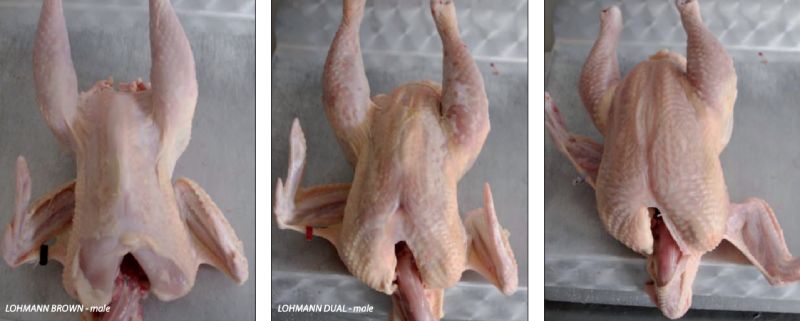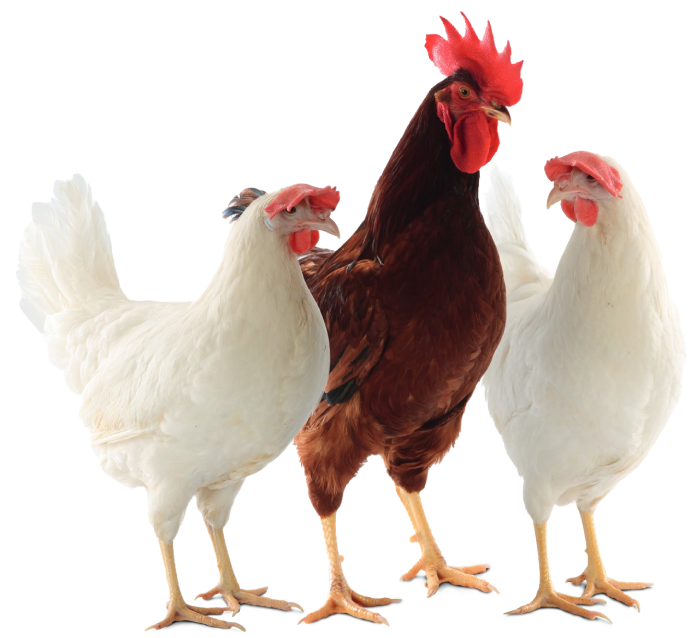Dear readers,
As you may perhaps remember, we announced the two new layer lines, LB- and LSL-Converter in the last edition of our Lohmann Poultry News. Two layers which have an excellent feed conversion ratio thereby contributing to more sustainability and conservation of resources. Aside from economical aspects, ethical aspects also need to be considered in animal breeding. One of these animal welfare issues is indisputably the culling of day-old male layers. Therefore, different strategies and approaches, e.g. sex determination on incubated or rather on non-incubated eggs have to be further developed or rather, the utilisation of male layer chicks need to be extensively explored. In regard to the rearing of males, one proposal is the socalled “Spring Chicken” and the other, the dual purpose chicken. What exactly is a dual purpose chicken? Which performances can be expected and how the concept looks like from an economical point of view, are described in the following article.
Whilst hens lay eggs, the cockerels have to gain more meat. The dual purpose chicken unites both of these production forms, but it may also require a compromise from both sides: Laying more eggs and at the same time gaining more meat, is simply implausible. Nevertheless, with the crossbreed “LOHMANN DUAL”,we have attempted to achieve this act of balance.
Contrary to the new Converter line which is the result of precise selection from existing lines, the LOHMANN DUAL is a new cross between layer and broiler genetics and combines the advantages of both breeding lines in the best way possible. All females and males of the same hatch are either reared together or separately. However, in order to exploit their full growing potential, males need to be reared separately. If you rear both genders together, you will have to orientate on the females to optimally prepare them for laying. However, in using standardised grower and developer laying hen feed, losses in meat gain on the part of the male has to be accepted. On the other hand, heated houses for the first weeks are linked to high energy costs which can be used more efficiently when rearing all the chicks together.

Lohmann DUAL Layer
Unlike the LOHMANN BROWN, LOHMANN DUAL layers have a larger appetite. In production, feed consumption is up to 140 g per hen and day. Together with an expected egg number of 250 eggs per annum and a slightly lighter egg weight, Lohmann Dual has a less favourable feed efficiency than LOHMANN BROWN. When including feed costs from rearing into economic calculations, feeding expenses alone are € 3 higher per hen housed up to 68 weeks of age, i.e. assuming a feed price of € 35 / 100 kg of feed. Furthermore, egg weight is in a much higher range for Lohmann Dual than it is for Lohmann Brown layers. Egg size is particularly smaller at the beginning of production.
Less eggs and additionally, smaller eggs, reduce egg mass production and therefore, the profit per hen. The difference in profit between LOHMANN DUAL and LOHMANN BROWN minus feed costs is € 6 per bird. This economic disadvantage as well as the appreciable lower ecological balance, resulting from a higher feed intake with simultaneously reduced production of high-quality food, can only be compensated to a small extent by an increased gain of meat in LOHMANN DUAL birds. A practicable and economically viable egg production via dual purpose chickens is therefore only possible when these eggs are sold at a higher egg price. The lighter brown eggshell colour which is clearly different as compared to LOHMANN BROWN eggs, could be helpful to point out that Lohmann Dual eggs do indeed have a unique feature.

Figure 2: Comparison on eggshell colour: Lohmann Dual vs. Lohmann Brown
LOHMANN DUAL birds. A practicable and economically viable egg production via dual purpose chickens is therefore only possible when these eggs are sold at a higher egg price. The lighter brown eggshell colour which is clearly different as compared to LOHMANN BROWN eggs, could be helpful to point out that Lohmann Dual eggs do indeed have a unique feature.
Table 1: Economic comparison of Lohmann Dual layers


Figure 1: Egg production of currently tested Lohmann Dual layers as well as the breeding target of this cross and standard Lohmann Brown performance.
Lohmann Dual Male/Broiler
Live weight gain in LOHMANN DUAL is moderate in comparison to a slow-growing broiler. From week three until ten weeks of age, dual birds and broilers grow further apart. Even on a long-term fattening period of 12 weeks, slow-growing broilers might already become adipose although both breeds had a slight difference in body weight. Fed with broiler diets for 70 days, the dual cockerels attained a live weight of 3 kg. The weight of the carcass was around 2 kg. In terms of carcass performance, there were hardly any differences between the dual cockerels and conventional broilers. The amount of valuable parts was at 50 %. Unlike special broiler lines, dual cockerels have a much lesser portion of breast meat in favour of the portion of the thighs.
The fattening performance of LOHMANN DUAL males is very satisfactory. Feed conversion ratio is with 1:2.5 much better as compared to a LOHMANN BROWN cockerel (1:4). However, the economic advantage of € 1.20 for one cockerel of LOHMANN DUAL is accompanied by an economic disadvantage of € 6.00 for each LOHMANN DUAL Layer which is due to 40 % higher feed expenses per egg. Furthermore, the production cycle of aLOHMANN DUAL layer is at this time much shorter than for LOHMANN BROWN layers. At an age of 68 weeks, laying performance of LOHMANN DUAL is decreased to less than 50 %. Therefore, a prolonged production period to 75/80 weeks of age is unprofitable. However, there is some good news too. So far, all performances for Lohmann Dual shown are based on an unselected flock. This means, the LOHMANN DUAL birds available are the first approach.
By consequent performance testing and selection on LOHMANN layers, genetic progress in relevant traits can be expected in the coming years.
Dr. Wiebke Icken and Dr. Matthias Schmutz,
Genetics
Table 2: Economic comparison Lohmann Dual – male

Figure 3. Live weight development of slow-growing broilers vs. Lohmann Dual males fattened in regard to laying hen rearing recommendations or respectively, to a broiler management.

Figure 4: Comparison of carcasses at 70 Days of age (Lohmann Brown – male, Lohmann Dual – male, slow growing broiler)

As you may perhaps remember, we announced the two new layer lines, LB- and LSL-Converter in the last edition of our Lohmann Poultry News. Two layers which have an excellent feed conversion ratio thereby contributing to more sustainability and conservation of resources. Aside from economical aspects, ethical aspects also need to be considered in animal breeding. One of these animal welfare issues is indisputably the culling of day-old male layers. Therefore, different strategies and approaches, e.g. sex determination on incubated or rather on non-incubated eggs have to be further developed or rather, the utilisation of male layer chicks need to be extensively explored. In regard to the rearing of males, one proposal is the socalled “Spring Chicken” and the other, the dual purpose chicken. What exactly is a dual purpose chicken? Which performances can be expected and how the concept looks like from an economical point of view, are described in the following article.
Whilst hens lay eggs, the cockerels have to gain more meat. The dual purpose chicken unites both of these production forms, but it may also require a compromise from both sides: Laying more eggs and at the same time gaining more meat, is simply implausible. Nevertheless, with the crossbreed “LOHMANN DUAL”,we have attempted to achieve this act of balance.
Contrary to the new Converter line which is the result of precise selection from existing lines, the LOHMANN DUAL is a new cross between layer and broiler genetics and combines the advantages of both breeding lines in the best way possible. All females and males of the same hatch are either reared together or separately. However, in order to exploit their full growing potential, males need to be reared separately. If you rear both genders together, you will have to orientate on the females to optimally prepare them for laying. However, in using standardised grower and developer laying hen feed, losses in meat gain on the part of the male has to be accepted. On the other hand, heated houses for the first weeks are linked to high energy costs which can be used more efficiently when rearing all the chicks together.

Lohmann DUAL Layer
Unlike the LOHMANN BROWN, LOHMANN DUAL layers have a larger appetite. In production, feed consumption is up to 140 g per hen and day. Together with an expected egg number of 250 eggs per annum and a slightly lighter egg weight, Lohmann Dual has a less favourable feed efficiency than LOHMANN BROWN. When including feed costs from rearing into economic calculations, feeding expenses alone are € 3 higher per hen housed up to 68 weeks of age, i.e. assuming a feed price of € 35 / 100 kg of feed. Furthermore, egg weight is in a much higher range for Lohmann Dual than it is for Lohmann Brown layers. Egg size is particularly smaller at the beginning of production.
Less eggs and additionally, smaller eggs, reduce egg mass production and therefore, the profit per hen. The difference in profit between LOHMANN DUAL and LOHMANN BROWN minus feed costs is € 6 per bird. This economic disadvantage as well as the appreciable lower ecological balance, resulting from a higher feed intake with simultaneously reduced production of high-quality food, can only be compensated to a small extent by an increased gain of meat in LOHMANN DUAL birds. A practicable and economically viable egg production via dual purpose chickens is therefore only possible when these eggs are sold at a higher egg price. The lighter brown eggshell colour which is clearly different as compared to LOHMANN BROWN eggs, could be helpful to point out that Lohmann Dual eggs do indeed have a unique feature.

Figure 2: Comparison on eggshell colour: Lohmann Dual vs. Lohmann Brown
LOHMANN DUAL birds. A practicable and economically viable egg production via dual purpose chickens is therefore only possible when these eggs are sold at a higher egg price. The lighter brown eggshell colour which is clearly different as compared to LOHMANN BROWN eggs, could be helpful to point out that Lohmann Dual eggs do indeed have a unique feature.
Table 1: Economic comparison of Lohmann Dual layers


Figure 1: Egg production of currently tested Lohmann Dual layers as well as the breeding target of this cross and standard Lohmann Brown performance.
Lohmann Dual Male/Broiler
Live weight gain in LOHMANN DUAL is moderate in comparison to a slow-growing broiler. From week three until ten weeks of age, dual birds and broilers grow further apart. Even on a long-term fattening period of 12 weeks, slow-growing broilers might already become adipose although both breeds had a slight difference in body weight. Fed with broiler diets for 70 days, the dual cockerels attained a live weight of 3 kg. The weight of the carcass was around 2 kg. In terms of carcass performance, there were hardly any differences between the dual cockerels and conventional broilers. The amount of valuable parts was at 50 %. Unlike special broiler lines, dual cockerels have a much lesser portion of breast meat in favour of the portion of the thighs.
The fattening performance of LOHMANN DUAL males is very satisfactory. Feed conversion ratio is with 1:2.5 much better as compared to a LOHMANN BROWN cockerel (1:4). However, the economic advantage of € 1.20 for one cockerel of LOHMANN DUAL is accompanied by an economic disadvantage of € 6.00 for each LOHMANN DUAL Layer which is due to 40 % higher feed expenses per egg. Furthermore, the production cycle of aLOHMANN DUAL layer is at this time much shorter than for LOHMANN BROWN layers. At an age of 68 weeks, laying performance of LOHMANN DUAL is decreased to less than 50 %. Therefore, a prolonged production period to 75/80 weeks of age is unprofitable. However, there is some good news too. So far, all performances for Lohmann Dual shown are based on an unselected flock. This means, the LOHMANN DUAL birds available are the first approach.
By consequent performance testing and selection on LOHMANN layers, genetic progress in relevant traits can be expected in the coming years.
Dr. Wiebke Icken and Dr. Matthias Schmutz,
Genetics
Table 2: Economic comparison Lohmann Dual – male

Figure 3. Live weight development of slow-growing broilers vs. Lohmann Dual males fattened in regard to laying hen rearing recommendations or respectively, to a broiler management.

Figure 4: Comparison of carcasses at 70 Days of age (Lohmann Brown – male, Lohmann Dual – male, slow growing broiler)







